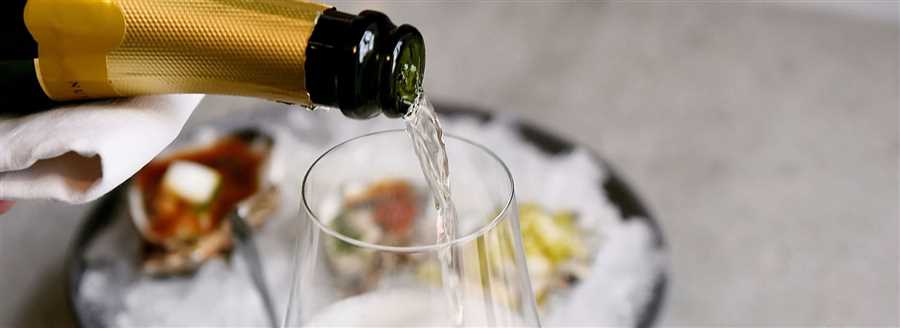Prosecco, with its crisp and fruity flavor, has become a popular choice for celebratory toasts and refreshing cocktails. But can you use Prosecco in your cooking? The answer is a resounding yes!
Prosecco can add a delightful touch to a variety of dishes, from savory sauces to sweet desserts. Its effervescent quality can bring a unique and vibrant flavor to your culinary creations.
One popular way to use Prosecco in cooking is to reduce it down into a syrupy glaze. This can be drizzled over roasted meats like chicken or pork, or used to elevate a simple fruit salad. The sweet and tangy notes of the Prosecco glaze can beautifully complement the flavors of both savory and sweet dishes.
In addition to glazes, Prosecco can be used in marinades for seafood, such as shrimp or scallops. The acidity in Prosecco can help to tenderize the seafood while infusing it with a delicate flavor. It can also be used in risottos, pasta sauces, and even in baking. Prosecco can add a touch of sophistication to traditional recipes and give them a modern twist.
However, it’s important to consider the alcohol content when using Prosecco in cooking. Most of the alcohol will evaporate during the cooking process, but a small amount may remain. This can be a concern for those avoiding alcohol or for dishes that are being prepared for children. It’s always a good idea to check the alcohol content before using Prosecco, and to adjust the amount accordingly.
So, the next time you’re looking to add a touch of elegance and sparkle to your culinary creations, don’t hesitate to reach for a bottle of Prosecco. Whether you’re cooking a special meal for a loved one or simply want to elevate your everyday dishes, Prosecco can be a versatile and flavorful addition to your kitchen.
Can I Use Prosecco for Cooking?
When it comes to cooking with alcohol, Prosecco is a popular choice among chefs and home cooks alike. This Italian sparkling wine has a light and fruity flavor that can add depth and complexity to a variety of dishes.
Benefits of Cooking with Prosecco
Using Prosecco in your cooking offers a range of benefits:
- Enhances Flavor: Prosecco can enhance the flavor profile of your dishes, especially those that include creamy or rich ingredients. Its light and vibrant taste can add a refreshing twist to sauces, reductions, and dressings.
- Tenderizes Meat: The natural acidity of Prosecco can help tenderize meat by breaking down its proteins. This makes it an excellent choice for marinades and braising liquids.
- Imparts Aroma: Prosecco’s floral and fruity notes can bring a delightful aroma to your recipes, creating a more enjoyable dining experience.
How to Use Prosecco in Cooking
Prosecco can be used in a variety of ways when cooking:
| Method | Example |
|---|---|
| Marinade | Marinate chicken or seafood in Prosecco before grilling for added flavor and tenderness. |
| Sauce | Add Prosecco to creamy sauces, such as Alfredo or carbonara, to lighten the flavors. |
| Reduction | Reduce Prosecco with sugar and spices to create a flavorful syrup for drizzling over desserts. |
| Desserts | Use Prosecco in desserts like fruit salads, sorbets, or poached fruits for a touch of elegance. |
It’s important to note that when cooking with Prosecco, the alcohol will evaporate, leaving behind the flavor and aroma. However, you should always be mindful of any dietary restrictions or preferences of your guests when using alcohol in your cooking.
So, the next time you’re looking to add a little sparkle to your dishes, consider using Prosecco. Its unique flavor and versatility make it a fantastic ingredient in both sweet and savory recipes.
Prosecco in Savory Dishes
One popular way to use Prosecco in savory cooking is to create a reduction sauce. The natural sweetness of Prosecco can be balanced with other savory ingredients like shallots, garlic, or herbs to create a flavorful sauce that pairs well with meats, seafood, or vegetables.
Prosecco can also be used in marinades or brines. The acidity of the wine helps to tenderize meat, while the aroma and flavor of the Prosecco infuse into the ingredients. This can result in a delicious and moist final dish, whether it’s grilled, roasted, or braised.
Additionally, Prosecco can be used to deglaze pans when cooking meats or vegetables. The bubbles in the wine help to lift and incorporate the flavorful browned bits that are left behind after cooking. This adds depth and complexity to the dish.
Another fun way to incorporate Prosecco into savory dishes is by using it as a poaching liquid. Poaching foods in Prosecco adds a delicate and aromatic flavor to the ingredients, making them tender and flavorful. This technique works particularly well for fruits, seafood, or even eggs.
When using Prosecco in savory dishes, it’s important to choose a bottle that you enjoy drinking. The quality and flavor of the wine will greatly impact the final dish. Whether you’re cooking a fancy dinner or simply experimenting in the kitchen, Prosecco can add a unique twist to your savory recipes.
Note: When using alcohol in cooking, keep in mind that the alcohol content will be partially cooked off. However, not all alcohol will evaporate, so be mindful of any dietary restrictions or preferences.
Adding Prosecco to Desserts
Prosecco, a sparkling Italian wine, can add a delightful touch to desserts with its crisp and fruity flavor. Whether you are making a cake, mousse, or pudding, incorporating Prosecco can elevate the taste and create a unique dining experience. Here are a few ideas on how to use Prosecco in your sweet treats:
Prosecco-infused Cake
Adding Prosecco to your cake batter can give it a moist and tender texture while infusing it with a subtle citrusy note. Replace a portion of the liquid in your recipe with Prosecco for a refreshing twist. Be sure to balance the proportion of liquid to maintain the desired consistency of the batter.
Tip: Brushing the Prosecco on the cake layers before frosting can enhance the flavor and keep the cake moist.
Prosecco Gelatin Desserts

Prosecco gelatin desserts, like Prosecco jelly or Prosecco panna cotta, can be an elegant and refreshing addition to your dessert menu. The bubbles in the Prosecco can create a light and airy texture, making it a perfect base for gelatin-based desserts. Pair it with fresh fruits like raspberries or strawberries to balance the sweetness.
Tip: Garnish your Prosecco gelatin desserts with a drizzle of Prosecco syrup or some edible flowers for an extra touch of elegance.
Prosecco can also be used in a variety of other desserts, such as Prosecco truffles, Prosecco sorbet, or even Prosecco-infused fruit salads. Its versatility allows you to experiment and create delightful desserts that will tantalize your taste buds.
In conclusion, Prosecco can be a fantastic addition to your dessert recipes. By using it creatively, you can transform ordinary desserts into extraordinary ones, impressing your guests and adding a touch of sophistication to your culinary creations.
Using Prosecco as a Marinade

Prosecco is not only a delicious sparkling wine to enjoy on its own or in cocktails, but it can also be used as a flavorful marinade for your favorite meats and vegetables. The effervescence and acidity of Prosecco adds a unique twist to traditional marinades, infusing dishes with a burst of flavor.
Prosecco works particularly well as a marinade for seafood, such as shrimp, scallops, and fish. The light and crisp nature of Prosecco pairs perfectly with lighter proteins, resulting in a moist and flavorful final product. Simply marinate the seafood for 30 minutes to an hour in a mixture of Prosecco, lemon juice, garlic, and herbs, and then grill, bake, or sauté as desired.
Prosecco can also be used to marinate chicken and pork, adding a touch of elegance to your weeknight meals. The bright and fruity notes of Prosecco pair well with the richness of these meats, resulting in a balanced and delicious dish. Combine Prosecco with olive oil, balsamic vinegar, herbs, and spices to create a marinade that will make your chicken or pork tender and flavorful.
Vegetables can also benefit from a Prosecco marinade. Grilling or roasting vegetables marinated in Prosecco can add a unique and complex taste to your dishes. Combine Prosecco with olive oil, vinegar, and your favorite herbs and spices to create a marinade that will enhance the natural flavors of vegetables such as asparagus, bell peppers, and zucchini.
When using Prosecco as a marinade, it is best to use a mid-range Prosecco that is not overly sweet or flavored. This will allow the natural flavors of the wine to shine through without overpowering the other ingredients. Remember to always marinate in a glass or stainless steel dish and discard any leftover marinade that has come into contact with raw meat or seafood to ensure food safety.
| Meat/Seafood | Prosecco Marinade Recipe |
|---|---|
| Shrimp | Prosecco, lemon juice, garlic, herbs |
| Scallops | Prosecco, lemon juice, garlic, herbs |
| Fish | Prosecco, lemon juice, garlic, herbs |
| Chicken | Prosecco, olive oil, balsamic vinegar, herbs, spices |
| Pork | Prosecco, olive oil, balsamic vinegar, herbs, spices |
| Vegetables | Prosecco, olive oil, vinegar, herbs, spices |
Questions and answers
What is prosecco and why is it popular?
Prosecco is a sparkling wine from Italy, specifically from the Veneto region. It is popular because of its light and refreshing taste, as well as its affordability compared to other sparkling wines like Champagne.
Can I use prosecco for cooking?
Yes, prosecco can be a great ingredient to use in cooking. Its bright and bubbly flavor can add a unique twist to a variety of dishes, such as risotto, sauces, and desserts.
What are some popular dishes that use prosecco?
Some popular dishes that use prosecco include prosecco risotto, prosecco-poached pears, and prosecco shrimp scampi. These dishes take advantage of the wine’s delicate flavor and effervescence.
Does the alcohol cook off when using prosecco in recipes?
Some of the alcohol does cook off when using prosecco in recipes, but not all of it. The exact amount that remains will depend on factors such as cooking time and temperature. However, it is safe to say that the final dish will still contain some alcohol.
Are there any substitutes for prosecco in recipes?
If you don’t have prosecco on hand, you can use other sparkling wines as a substitute. Champagne, Cava, or even a dry sparkling white wine can work well in most recipes that call for prosecco. Just keep in mind that the flavor may be slightly different.






